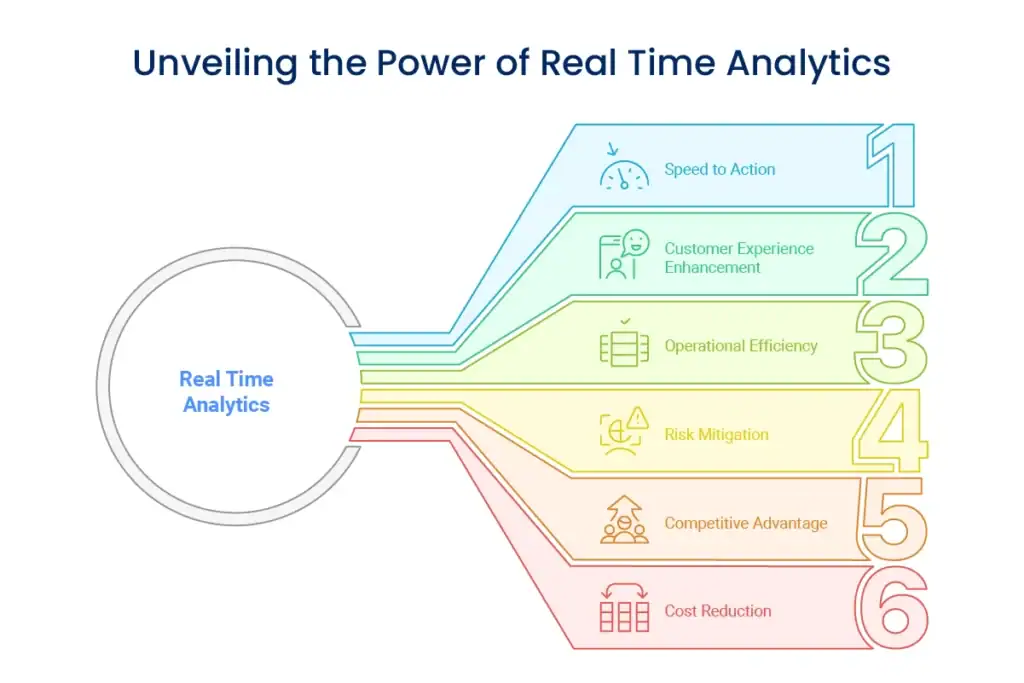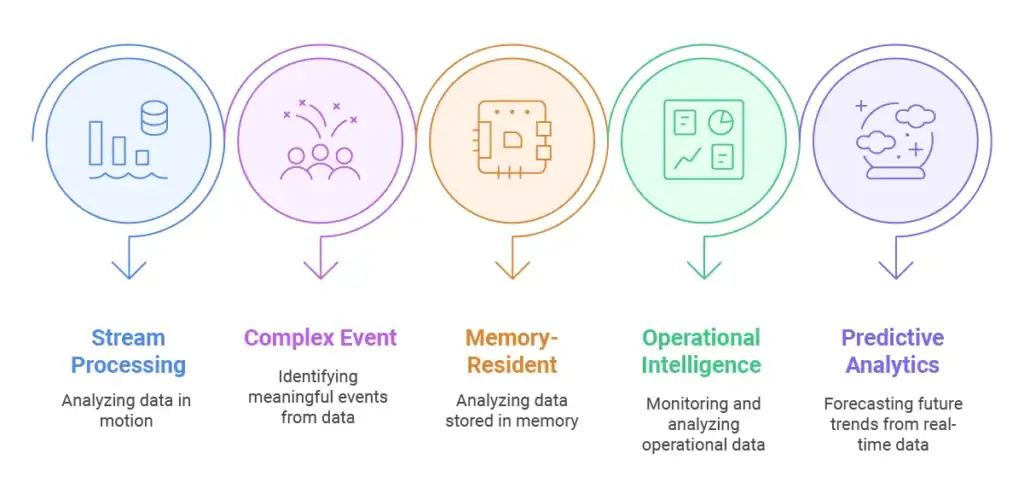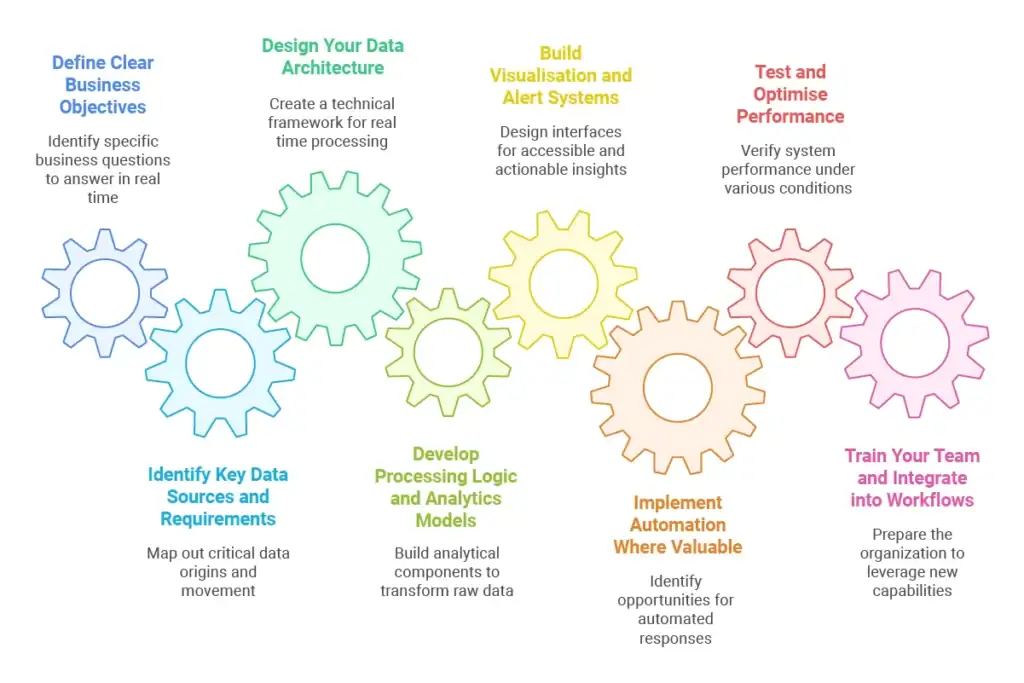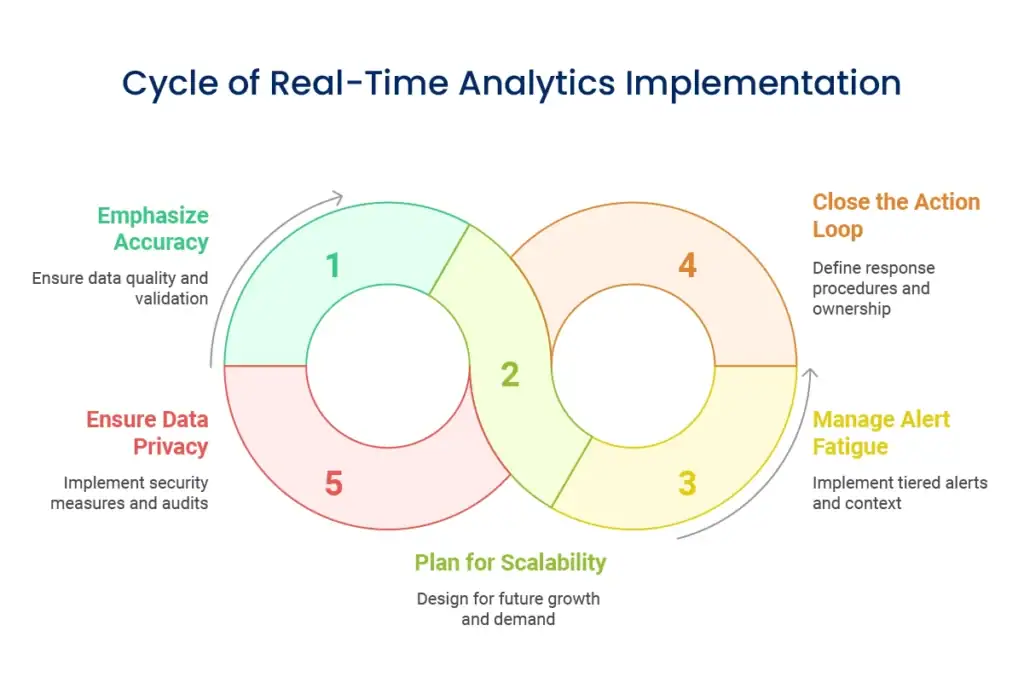Custom Design
You’ve probably been in this situation: you make a key business decision on the basis of data from last week, only to find that the environment shifted hours prior, making your decision moot. What if you could observe changes in real-time and react immediately?
Real time analytics changes the way businesses work by giving you instantaneous answers from your data the moment it’s generated. Instead of looking in the rearview mirror at what occurred yesterday, last month, or last quarter, real time analytics allows you to look at what’s occurring now—making quicker, better decisions that can make or break an opportunity.

Real time analytics is the practice of gathering, analysing, and taking action on data while it’s being created, with little time delay between data creation and insight provision. Unlike batch-oriented traditional analytics that processes data hours or days after it is gathered, real time analytics operates around the clock, processing information in seconds or milliseconds of creation.
Imagine legacy analytics as watching security video the next day after something happens, whereas real time analytics is like having a security officer monitor the feed in real-time and react as events happen.
The tech brings together several elements:
For companies, real time analytics means immediately translating into quicker response rates, lower risk, and the opportunity to seize momentary opportunities that would otherwise be lost with slow analysis.

The transition from periodic to continuous analysis is a core transformation in how companies compete and do business. Here’s why it counts:

Narrow the gap between event occurrence and business response from days to seconds, enabling you to deal with issues before they become larger problems or seize opportunities before others.
Personalse interactions with customers while they're actively still interacting with your brand, as opposed to strategizing about their return visit. This results in greater satisfaction rates and loyalty.
Spot and fix inefficiencies, bottlenecks, or machine breakdowns the minute they start to occur, reducing downtime and optimizing resource usage.
Identify suspicious trends that could signal fraud, security violations, or market change early on and enable defensive action prior to considerable damage.
Businesses utilizing real time analytics can react to market fluctuations more rapidly than others who use batch processing, providing a huge competitive advantage in fast-moving markets.
Avoid inventory shortages, excess production, or misutilization of assets by adapting processes in response to prevailing conditions instead of historical trends.
Various business needs demand various methods of real time analytics. Knowing these methods guides you into choosing the appropriate framework to suit your particular needs.

Stream processing constantly examines data as it moves through your systems without waiting for it to be saved initially. This method is best suited for applications with critical timing requirements.
For instance, an online shopping website may employ stream processing to analyze customer browsing behavior and automatically suggest related products when the consumer is engaged in shopping, thus maximizing chances of future purchases. This feature has a direct relation to conversion rates and average order value.
Stream processing enables companies to react to events with minimal latency and is therefore critical for time-critical applications such as anti-money laundering or real-time auctioning systems.
CEP spots significant patterns in multiple streams of data, seeing connections between unrelated events to identify sophisticated scenarios.
A financial services organization could apply CEP to identify fraud opportunity through correlating suspicious transaction locations, amounts, and timing with the customer’s normal behavior patterns. Connecting these dots in real time, the system can alert on suspicious activity prior to transaction completion.
This design is best for identifying scenarios that need to analyze many conditions concurrently, with more advanced results than single-stream analysis.
These infrastructures hold pertinent data in high-speed memory instead of disk, lowering access times considerably and allowing the analysis to occur faster.
A retail organization employing memory-resident analytics would be able to immediately determine the effect of an offer across all outlets, enabling managers to correct pricing or inventory distribution on an ongoing basis while the offer is active instead of waiting until it has ended.
For companies handling large volumes of data that needs to be accessed quickly, memory-resident analytics provides performance benefits that directly translate to decision-making speed.
These systems emphasize monitoring and streamlining business operations in real time, frequently applying analytics together with automation to automate processes.
A factory may use operational intelligence to track the performance of equipment, automatically modifying machine settings when factors indicate possible problems or inefficiencies. This minimizes downtime and improves product quality.
Operational intelligence assists companies in maintaining peak performance by affording continuous insight into process efficiency and allowing for instant changes.
This cutting-edge structure isn’t only revealing what’s presently occurring but also forecasting what will occur next through existing data streams and past trends.
An airline using predictive real time analytics may be able to anticipate future flight delays using existing weather patterns, airport situations, and incoming flight statuses and, thus, proactively modify schedules and alert passengers even before issues arise.
The forecasting ability places real time insights in the role of proactive planning tool rather than reactive tool, enabling companies to resolve challenges before they occur at full force.
Building an effective real time analytics system requires careful planning and execution. Follow these steps to develop a solution that delivers genuine business value.

Start by defining specific business questions you must answer in real time. These goals must connect directly to business results such as revenue, cost savings, or customer satisfaction. For instance, instead of stating “we need real time sales information,” state “we need to determine underperforming products within 15 minutes of sales deterioration so we can adjust pricing or promotion strategies immediately.” These clear goals will inform all future implementation decisions.
Plot where your key data comes from and how it flows across your organisation. Think about:
Assess each source on accessibility, quality, and latency to identify which systems must be changed in order to accommodate real time capabilities.
Develop a technical design capable of meeting the speed and volume demands of real time processing:
The design must emphasize low latency while ensuring data integrity and availability.
Construct the analytical pieces that translate raw data into decisionable information:
Begin with basic models and evolve them over time as you gain a deeper understanding of your real time data patterns.
Create interfaces that bring insights to life and make them actionable:
Prioritize simplicity and relevance over complexity, ensuring users can easily see what needs attention.
Identify areas where it is possible to automatically respond to some conditions:
Automation maximizes the power of real time analytics by shrinking the lead time for insight to action.
Ensure your system works as designed under diverse circumstances:
Tune for better performance, concentrating on removing bottlenecks affecting business-critical processes.
Get your organisation ready to take advantage of the new capabilities:
The most advanced system is not that useful if people are not trained to make the most of it in their day-to-day work.
Choosing the appropriate tools can make a big difference in the success of your implementation of real time analytics. Some of the following are worth looking into for various aspects of the process:
An open-source event streaming platform with distributed architecture that is able to handle high-volume, real-time data feeds with high reliability. Great for building central data pipelines between multiple systems.
A managed service for gathering, processing, and analyzing streaming data in real time. Best suited for businesses already leveraging AWS services.
Offers scalable, high-throughput, fault-tolerant stream processing as part of the Apache Spark platform.
Serverless real time analytics that makes ingestion, processing, and analysis of streaming data easier.
Provides real-time dashboarding with direct streaming data source connections and automatic refreshing.
Part of the Elastic Stack, excellent for visualising log and event data in real time.
Microsoft's business analytics service that offers real-time dashboarding features and complements well with other Microsoft tools.
Open-source analytics and interactive visualization platform, very capable at working with time-series data and metrics.
The appropriate set of tools varies based on your particular needs, current technology stack, and staff capabilities. Most organisations employ a combination of these technologies to construct a total solution.
Even well-planned real time analytics initiatives may run into problems. An awareness of these pitfalls can help you steer clear of them:

Although speed is crucial in real time analytics, accuracy takes precedence. Instant but incorrect analysis outputs can cause damaging decisions.
How to avoid: Insert data quality checks in your processing pipeline and cross-check outputs against known reference points. Make systems alert for low-confidence results and insist on further verification before initiating important actions.
Most real time systems function flawlessly at first implementation but fail when the volumes of data increase or the number of users increases.
How to avoid: Plan your architecture for future growth. Test with several orders of magnitude more data than current requirements. Leverage cloud-based elastic resources that can automatically scale up and down with usage.
Mistakenly configured real time systems can drown users in messages, causing them to ignore alerts outright—even critical ones.
How to avoid: Use tiered alerting with transparent priority levels. Begin with conservative settings and adjust according to customer feedback. Add context to alerts so users can immediately grasp their priority.
Certain organizations spend a lot on identifying real time events but fail to create discernible processes for acting on them, diluting the value of the insight.
How to avoid: For every key metric or alert type, establish clear response processes and own up to each clearly. Establish feedback loops to measure if actions were performed and what results followed.
The pace of real time systems at times creates shortcuts in security procedures, resulting in vulnerability to data breaches or compliance exposures.
How to avoid: Involve security professionals in the development phase. Use proper authentication, encryption, and access controls from the start. Periodically audit data transfers for adherence to applicable regul
The capacity for analyzing and taking action on data in real time is a basic change in the way companies compete and do business. While technologies will continue to advance and quantities of data expand, real time analytics will move from competitive tool to core business need.
You do not have to rip out the existing system to begin your real time analytics journey. Pilot with a particular high-value use case where real time insights can have direct effect on results. Leverage this first project to establish expertise, show value, and generate momentum for wider adoption.
Keep in mind that effective real time analytics is not solely about technology—it takes organisational alignment, process evolution, and a data-driven decision-making culture. The most sophisticated systems provide little benefit if insights are not acted upon.
Through careful enactment of real time analytics abilities, your organisation can become more responsive to shifts in the market, more sensitive to customers’ needs, and more streamlined for operations—gaining sustainable benefits in a rapidly competitive environment.
To grasp and incorporate effective analytics and reporting systems is not easy. If you are planning on creating or refining your real time analytics capabilities, think about seeking professional advice to speed up your path and prevent pitfalls.
The proper strategic approach has the ability to help you recognize the most valuable opportunities, choose the best technologies, and create implementation plans aligned with your business goals. Through expert guidance, you can make your data into a strategic asset that generates quantifiable business outcomes through timely insights and responsive decision-making.

Enter your email to get instant access